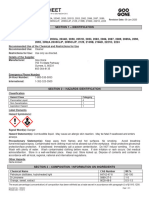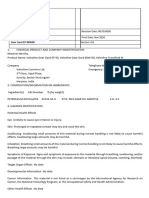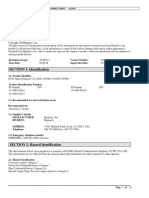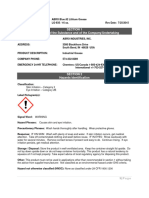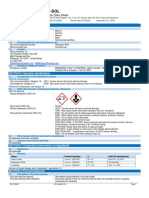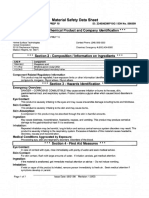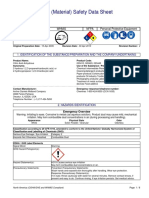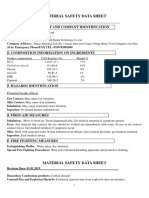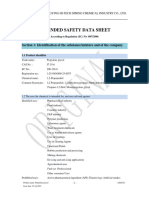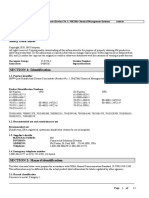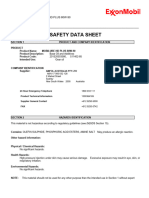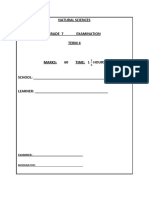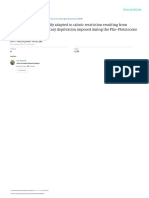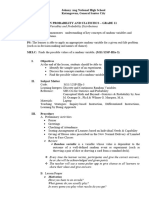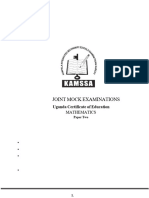MSDS Goo Gone
MSDS Goo Gone
Uploaded by
Medio AmbienteCopyright:
Available Formats
MSDS Goo Gone
MSDS Goo Gone
Uploaded by
Medio AmbienteOriginal Title
Copyright
Available Formats
Share this document
Did you find this document useful?
Is this content inappropriate?
Copyright:
Available Formats
MSDS Goo Gone
MSDS Goo Gone
Uploaded by
Medio AmbienteCopyright:
Available Formats
SAFETY DATA SHEET
Confirms to OSHA Hazard Communication Standard (CFR 29 1910.1200) HazCom 2012
Goo Gone- 2028, 2030, 2030A, 2050, 2053, 2082, 2086, 2087, 2089, 2090, 2092,
Product: Revision Date: 12-Jun-2018
2035CLIP, 2095CLIP, 2129, 2139B, 2166D, 2221D, 2223
SECTION 1 – IDENTIFICATION
Product Identifier
Product Name: Goo Gone
Product Code: 2028, 2030, 2030A, 2050, 2053, 2082, 2086, 2087, 2089, 2090, 2092, 2035CLIP,
2095CLIP, 2129, 2139B, 2166D, 2221D, 2223
Recommended Use of the Chemical and Restrictions for Use
Recommended Use: Cleaner
Restrictions for Use: Use only as directed.
Details of the Supplier
Manufacturer: Goo Gone .
755 Tri-State Parkway
Gurnee, IL 60031
855-364-8135
Emergency Phone Number
24-Hour Number: 1-800-535-5053
International: 1-352-323-3500
SECTION 2 – HAZARDS IDENTIFICATION
Classification
Hazard Class Category
Flammable Liquid 4
Skin Sensitization 1
Aspiration Hazard 1
Label Elements
Hazard Symbols(s):
Signal Word(s): Danger
Hazard Statement(s): Combustible liquid. May cause an allergic skin reaction. May be fatal if swallowed and enters
airways.
Precautionary Statement(s): Keep away from flames and hot surfaces. No smoking. Avoid breathing
fume/mist/vapors/spray. Contaminated work clothing must not be allowed out of the workplace. Wear protective gloves/eye
protection/face protection. If swallowed: Immediately call a poison center/doctor. Do NOT induce vomiting. If on skin:
Wash with plenty of water. Wash contaminated clothing before reuse. If skin irritation or rash occurs: Get medical
advice/attention. Store in a well-ventilated place. Keep cool. Store locked up. Dispose of contents and container in
accordance with all local, regional, national and international regulations.
Other Hazards
None known
SECTION 3 – COMPOSITION / INFORMATION ON INGREDIENTS
Chemical Name CAS Number Wt %
Petroleum distillates, hydrotreated light 64742-47-8 60-100
D-Limonene 5989-27-5 1-5
Orange, sweet, extract 8028-48-6 0.5-1.5
The exact percentage (concentration) of composition has been withheld as a trade secret in accordance with paragraph (i) of §1910.1200.
Document No.: 130529-5 Page 1 of 5
Release Date: 1/10/2014
SAFETY DATA SHEET
Confirms to OSHA Hazard Communication Standard (CFR 29 1910.1200) HazCom 2012
Goo Gone- 2028, 2030, 2030A, 2050, 2053, 2082, 2086, 2087, 2089, 2090, 2092,
Product: Revision Date: 12-Jun-2018
2035CLIP, 2095CLIP, 2129, 2139B, 2166D, 2221D, 2223
SECTION 4 – FIRST AID MEASURES
First Aid Measures
Inhalation: If breathing is difficult, remove victim to fresh air and keep at rest in a position comfortable for breathing. Get
medical advice/attention if you feel unwell.
Eye Contact: Rinse immediately with water for at least 15 minutes. Remove contact lenses, if worn. If irritation persists,
seek medical attention immediately.
Ingestion: If swallowed, do NOT induce vomiting unless directed to do so by medical personnel. Never give anything by
mouth to an unconscious person. Get medical advice/attention if you feel unwell.
Skin: In case of contact, immediately flush skin with plenty of water. Remove contaminated clothing and shoes. Wash with
soap and water. If irritation persists, seek medical attention.
Most Important Symptoms and Effects (Acute and Delayed)
Inhalation: May cause respiratory track irritation.
Eye Contact: May cause eye irritation. Symptoms may include discomfort or pain, excess blinking and tear production, with
possible redness and swelling.
Ingestion: May be harmful if swallowed. May cause stomach distress, nausea or vomiting.
Skin: May cause skin irritation. Symptoms may include redness, drying, defatting and cracking of the skin. May cause
sensitization by skin contact.
Indication of any Immediate Medical Attention and Special Treatment Needed
Note to Physician: Treat symptomatically.
SECTION 5 – FIRE FIGHTING MEASURES
Extinguishing Media
Suitable: Treat for surrounding material.
Unsuitable: None known.
Specific Hazards Arising from Chemical
Products of combustion include but are not limited to: oxides of carbon.
Protective Equipment and Precautions for Firefighters
Keep upwind of fire. Wear full fire fighting turn-out gear (full Bunker gear) and respiratory protection (SCBA). As in any fire,
wear self-contained breathing apparatus pressure-demand, MSHA/NIOSH (approved or equivalent) and full protective gear.
SECTION 6 – ACCIDENTAL RELEASE MEASURES
Personal Precautions, Protective Equipment, and Emergency Procedures
Personal Precautions: Use personal protective equipment as required.
Environmental Precautions: See Section 12 for ecological information.
Methods and Material for Containment and Cleaning Up
Contain and/or absorb spill with inert material (e.g. sand, vermiculite), then place in a suitable container. Do not flush to
sewer or allow to enter waterways. Use appropriate Personal Protective Equipment (PPE). For cleaning up scoop up
material and place in a disposal container. Provide ventilation.
SECTION 7 – HANDLING AND STORAGE
Precautions for Safe Handling
Handling: Keep away from sources of ignition. No smoking. Avoid contact with skin and eyes. Avoid breathing
fume/mist/vapors/spray. Do not swallow. Handle and open container with care. When using do not eat, drink or smoke.
General Hygiene Advice: Launder contaminated clothing before use. Wash hands before eating, drinking, or smoking.
Document No.: 130529-5 Page 2 of 5
Release Date: 1/10/2014
SAFETY DATA SHEET
Confirms to OSHA Hazard Communication Standard (CFR 29 1910.1200) HazCom 2012
Goo Gone- 2028, 2030, 2030A, 2050, 2053, 2082, 2086, 2087, 2089, 2090, 2092,
Product: Revision Date: 12-Jun-2018
2035CLIP, 2095CLIP, 2129, 2139B, 2166D, 2221D, 2223
Conditions for Safe Storage, Including any Incompatibilities
Storage Conditions: Keep container closed when not in use. Store in a dry, cool, and well-ventilated area. Keep out of
reach of children.
Incompatible Materials: None known.
SECTION 8 – EXPOSURE CONTROLS/PERSONAL PROTECTION
Control Parameters
Exposure Guidelines:
Chemical Name ACGIH TLV OSHA PEL NIOSH IDLH
Petroleum distillates, hydrotreated light (64742-47-8) 200 mg/m3 100 ppm Not available
D-Limonene (5989-27-5) Not available Not available Not available
Orange, sweet, extract (8028-48-6) Not available Not available Not available
Appropriate Engineering Controls
Use ventilation adequate to keep exposures (airborne levels of dust, fume, vapor, etc.) below recommended exposure limits.
Individual Protection Measures
Respiratory Protection: None required under normal use conditions. In case of insufficient ventilation, wear suitable
respiratory equipment.
Skin and Body Protection: Wear suitable protective clothing.
Eye/Face Protection: Safety glasses or goggles are recommended when using product.
General Work/Hygienic Practices: Do not eat, smoke or drink where material is handled, processed or stored. Wash
hands carefully before eating or smoking. Handle in accordance with good industrial hygiene and safety practice.
SECTION 9 – PHYSICAL AND CHEMICAL PROPERTIES
Appearance: Yellow clear liquid
Odor: Citrus
Odor threshold: Not determined
pH: Not determined
Melting point/freezing point: Not determined
Initial boiling point and boiling range: Not determined
Flash point: 85°C (185°F) TCC
Evaporation rate: Not determined
Flammability (solid, gas): Flammable
Upper/lower flammability or explosive limits: Not determined
Vapor pressure: Not determined
Vapor density: Not determined
Relative density: 0.80
Solubility(ies): Not determined
Partition coefficient (n-octanol/water): Not determined
Auto-ignition temperature: Not determined
Decomposition temperature: Not determined
Viscosity: Not determined
SECTION 10 – STABILITY AND REACTIVITY
Reactivity: Not reactive under normal conditions.
Chemical stability: Stable under recommended storage conditions.
Document No.: 130529-5 Page 3 of 5
Release Date: 1/10/2014
SAFETY DATA SHEET
Confirms to OSHA Hazard Communication Standard (CFR 29 1910.1200) HazCom 2012
Goo Gone- 2028, 2030, 2030A, 2050, 2053, 2082, 2086, 2087, 2089, 2090, 2092,
Product: Revision Date: 12-Jun-2018
2035CLIP, 2095CLIP, 2129, 2139B, 2166D, 2221D, 2223
Possibility of hazardous reactions: None under normal use.
Conditions to avoid: Heat. Incompatible materials. Sources of ignition.
Incompatible materials: None known.
Hazardous decomposition products: May include and are not limited to: oxides of carbon.
SECTION 11 - TOXICOLOGICAL INFORMATION
Information on Toxicological Effects
Likely Routes of Exposure: Inhalation, skin contact, eye contact, ingestion
Information Related to Physical, Chemical, and Toxicological Effects
See section 4 of this SDS.
Delayed and Immediate Effects as well as Chronic Effects from Short and Long-term Exposure
Carcinogenicity: NTP: No IARC: No OSHA: No
Numerical Measures of Toxicity
Product
ATE (oral) >2000 mg/kg, rat
ATE (dermal) >2000 mg/kg, rabbit
ATE (inhalation) Not available
Component Information:
Chemical Name Oral LD50 Dermal LD50 Inhalation LC50
Petroleum distillates, hydrotreated light (64742-47-8) >5000 mg/kg, rat >2000 mg/kg, rabbit >5.2 mg/l/4h, rat
D-Limonene (5989-27-5) 4400 mg/kg, rat >5000 mg/kg, rabbit Not available
Orange, sweet, extract (8028-48-6) >5000 mg/kg, rat >5000 mg/kg, rabbit Not available
SECTION 12 - ECOLOGICAL INFORMATION
Ecotoxicity: Not established
Persistence and degradability: Not established
Bioaccumulative potential: Not established
Mobility in soil: No additional information available
Other adverse effects: No additional information available.
SECTION 13 – DISPOSAL CONSIDERATIONS
See section 8 of this SDS for exposure controls and personal protection.
Dispose of the product and container in accordance with all applicable local, state, and federal regulations.
SECTION 14 – TRANSPORT INFORMATION
Note: Classification changes based on quantity, packaging, and method of shipment. See current shipping paper for most
up to date shipping information.
DOT (Ground): Not Regulated- See 49 CFR 173.150(f)(2) as the product is not bulk packaged.
IATA (Air): Not Regulated
IMDG (Vessel): Not Regulated
SECTION 15 – REGULATORY INFORMATION
All ingredients in this product are listed or are excluded from listing on the US Toxic Substances Act (TSCA) Chemical
Substance Inventory.
Document No.: 130529-5 Page 4 of 5
Release Date: 1/10/2014
SAFETY DATA SHEET
Confirms to OSHA Hazard Communication Standard (CFR 29 1910.1200) HazCom 2012
Goo Gone- 2028, 2030, 2030A, 2050, 2053, 2082, 2086, 2087, 2089, 2090, 2092,
Product: Revision Date: 12-Jun-2018
2035CLIP, 2095CLIP, 2129, 2139B, 2166D, 2221D, 2223
This product is labeled in accordance with regulations administered by the Consumer Product Safety Commission (CPSC).
The use pattern and exposure in the workplace are generally not consistent with those experienced by consumers. The
requirements of the Occupational Safety and Health Administration (OSHA) applicable to this Safety Data Sheet differ from
the requirements of the CPSC and as a result, this SDS may contain additional health hazard information not pertinent to
consumer use and not found on the product label.
SECTION 16 – OTHER INFORMATION
Issue Date: 23-Aug-2017
Revision Date: 12-Jun-2018
The information provided in this Safety Data Sheet is correct to the best of our knowledge, information, and belief at the
date of its publication. The information given is designed only as guidance for safe handling, use, processing, storage,
transportation, disposal, and release and is not to be considered a warranty or quality specification. The information relates
only to the specific material designed and may not be valid for such material used in combination with any other materials
or in any process, unless specified in the text.
End of Safety Data Sheet
Document No.: 130529-5 Page 5 of 5
Release Date: 1/10/2014
You might also like
- Pin Jointed Truss LabreportDocument4 pagesPin Jointed Truss LabreportYong Jin100% (1)
- Self Coaching 55 Questions To Ask YourselfDocument36 pagesSelf Coaching 55 Questions To Ask YourselfSumanjit Kaur88% (8)
- MSDS - HelizymeDocument10 pagesMSDS - HelizymeNurhari OgiNo ratings yet
- Instructional Material Development (Imade) : Lopez, Quezon BranchDocument45 pagesInstructional Material Development (Imade) : Lopez, Quezon BranchNonel MenaNo ratings yet
- Msds Silicona Roja 65010 VersachemDocument8 pagesMsds Silicona Roja 65010 VersachemErik Evans Saravia0% (1)
- Extended Essay Skeleton Outline TemplateDocument4 pagesExtended Essay Skeleton Outline TemplateNatural Spring WaterNo ratings yet
- I Am Not Esther Sexy ParagraphsDocument36 pagesI Am Not Esther Sexy Paragraphsapi-317825538100% (2)
- SS 20306Document9 pagesSS 20306Moisés Antonio Gamboa MartínezNo ratings yet
- Safety Data Sheet: Section 1 - IdentificationDocument5 pagesSafety Data Sheet: Section 1 - Identificationluis armandoNo ratings yet
- Hoja de Datos de Seguridad Removedor Adhesivo Goo GoneDocument5 pagesHoja de Datos de Seguridad Removedor Adhesivo Goo GoneSupervisores SertresNo ratings yet
- Material Safety Data Sheet: Material Name: Insulating Cement Section 1-Chemical Product and Company IdentificationDocument6 pagesMaterial Safety Data Sheet: Material Name: Insulating Cement Section 1-Chemical Product and Company IdentificationNazirAhmadBashiriNo ratings yet
- Gear Gard EP 80W90Document5 pagesGear Gard EP 80W90JPR NotesNo ratings yet
- Safety Data Sheet: D108, Super Degreaser (22-160A) : D10801, D10805, D10855Document10 pagesSafety Data Sheet: D108, Super Degreaser (22-160A) : D10801, D10805, D10855AsadNo ratings yet
- ABRO GreaseDocument8 pagesABRO GreaseabdulNo ratings yet
- Safety Data Sheet: G70, Gold Class Paste Car Wax (21-124A) : G7014Document12 pagesSafety Data Sheet: G70, Gold Class Paste Car Wax (21-124A) : G7014Faizan NazirNo ratings yet
- KD Dol MsdsDocument5 pagesKD Dol MsdsSanjay SamantarayNo ratings yet
- Sigma-Aldrich: EthanolDocument8 pagesSigma-Aldrich: Ethanolalifia hajar amandaNo ratings yet
- Sigma-Alrich SDS (Year 2020)Document9 pagesSigma-Alrich SDS (Year 2020)BigbearBigbearNo ratings yet
- SDS Mequiers SDS Carnauba Wax WaterlessDocument11 pagesSDS Mequiers SDS Carnauba Wax WaterlessSiska DNo ratings yet
- Amoriguard A-GAIN-Filler-Skim-Filler-Grey-SDSDocument5 pagesAmoriguard A-GAIN-Filler-Skim-Filler-Grey-SDSMalungeloNo ratings yet
- Sds For FRABS 20200107 - ENDocument7 pagesSds For FRABS 20200107 - ENCarrie WuNo ratings yet
- Safety Data Sheet: Ethyl Alcohol, PureDocument9 pagesSafety Data Sheet: Ethyl Alcohol, PureTorero02No ratings yet
- Acetaldol MsdsDocument6 pagesAcetaldol Msdsdlr1233No ratings yet
- Escaid 110 Exxon MobileDocument11 pagesEscaid 110 Exxon MobilePatricio Santis CortésNo ratings yet
- Choice Organochem LLP: Material Safety Data SheetDocument7 pagesChoice Organochem LLP: Material Safety Data Sheetbyreddy maryleelaNo ratings yet
- Hygroscope P - Msds-EngDocument5 pagesHygroscope P - Msds-EngGİZEM DEMİRNo ratings yet
- MSDS - XA31163 - AD GOLD PLUS - 2025 - ENG - LTDocument8 pagesMSDS - XA31163 - AD GOLD PLUS - 2025 - ENG - LTLê Công VõNo ratings yet
- SGP53932Document7 pagesSGP53932simphiweNo ratings yet
- Acetone Safety Data Sheet PDFDocument8 pagesAcetone Safety Data Sheet PDFMarkChenNo ratings yet
- Fosroc - Nitocote PE 135Document8 pagesFosroc - Nitocote PE 135guru sathya bharathyNo ratings yet
- Safety Data Sheet: Product Name: MOBILUBE HD PLUS 80W-90Document9 pagesSafety Data Sheet: Product Name: MOBILUBE HD PLUS 80W-90BIMBAKILA BOUESSO Dastel JunielNo ratings yet
- Mekaconsul MOTUL TECH GREASE 300 SafetyDocument6 pagesMekaconsul MOTUL TECH GREASE 300 SafetyNatalia ZapataNo ratings yet
- Alpha Ketoglutaric AcidDocument9 pagesAlpha Ketoglutaric AcidSNo ratings yet
- Chemicals Zetag MSDS Beads Zetag 7565 - 0710Document6 pagesChemicals Zetag MSDS Beads Zetag 7565 - 0710PromagEnviro.comNo ratings yet
- Chemicals Zetag MSDS Powder Zetag 8140 - 0710Document6 pagesChemicals Zetag MSDS Powder Zetag 8140 - 0710PromagEnviro.comNo ratings yet
- Amsoil ACBDocument9 pagesAmsoil ACBTudor RatiuNo ratings yet
- Oil Eater Degreaser Cleaner Kafko InternationalDocument3 pagesOil Eater Degreaser Cleaner Kafko InternationalstevgonNo ratings yet
- Styrofan® 1186 Sds en UsDocument11 pagesStyrofan® 1186 Sds en Usdebra.mccollamNo ratings yet
- Chemicals Zetag MSDS Powder Zetag 8190S - 0710Document6 pagesChemicals Zetag MSDS Powder Zetag 8190S - 0710PromagEnviro.comNo ratings yet
- AcetaminophenDocument10 pagesAcetaminophenNakkiran ArulmozhiNo ratings yet
- SDS Ethyl AcetateDocument13 pagesSDS Ethyl AcetateHARNITH EVILLNo ratings yet
- MtBE SDSDocument2 pagesMtBE SDSWand LopesNo ratings yet
- 3m Scotch Glue StickDocument7 pages3m Scotch Glue StickSirhc ZialcitaNo ratings yet
- Citric Acid Ex ADMDocument8 pagesCitric Acid Ex ADMFebriani SpnNo ratings yet
- GB Tip Top Special Cleaning Solvent 0007Document8 pagesGB Tip Top Special Cleaning Solvent 0007Sai PrasathNo ratings yet
- 3M Scotchcast Re-Enterable Electrical InsulatingDocument26 pages3M Scotchcast Re-Enterable Electrical InsulatingPLN UPT MAKASSARNo ratings yet
- Bonnet Carpet CleanerDocument5 pagesBonnet Carpet CleanerAlexis MartinezNo ratings yet
- Ak - MSDSDocument4 pagesAk - MSDSHuongThi KhongNo ratings yet
- 2655-03 Ghs-En - MSDSDocument8 pages2655-03 Ghs-En - MSDSzaryab khanNo ratings yet
- Inkworld Oil Based Ink MsdsDocument3 pagesInkworld Oil Based Ink MsdsHarold MontesNo ratings yet
- MSDS EDTA Sigma-Aldrich ENDocument9 pagesMSDS EDTA Sigma-Aldrich ENDanielaNo ratings yet
- MSDS 743550Document9 pagesMSDS 743550jeandheytecnicaNo ratings yet
- MSDS 90033400 MolykoteDocument12 pagesMSDS 90033400 Molykotejaysx5No ratings yet
- MATERIAL SAFETY DATA SHEET SCOTCHKOTE 323 Patch, Brush, and Spray Grades, Part BDocument7 pagesMATERIAL SAFETY DATA SHEET SCOTCHKOTE 323 Patch, Brush, and Spray Grades, Part BleoNo ratings yet
- Omega-58 GB 7.0Document9 pagesOmega-58 GB 7.0Emmanuelle EspirituNo ratings yet
- SDS - Propilenoglicol - Dongying Hi-TechDocument15 pagesSDS - Propilenoglicol - Dongying Hi-TechCamquim ChemicalsNo ratings yet
- SD-20 All Purpose CleanerDocument5 pagesSD-20 All Purpose CleanerAlexis MartinezNo ratings yet
- Q2612a MSDSDocument7 pagesQ2612a MSDSevamedical1No ratings yet
- MSDS 3M Quat DisinfectantDocument13 pagesMSDS 3M Quat DisinfectantAhmad IssaNo ratings yet
- Qualic.q-Cool 330c.sds Eu - EnglishDocument9 pagesQualic.q-Cool 330c.sds Eu - EnglishtribolasNo ratings yet
- MSDS 743699Document9 pagesMSDS 743699Hussein SobhNo ratings yet
- Safety Data Sheet: 1. Identification of The Substance/Preparation and of The Company/UndertakingDocument12 pagesSafety Data Sheet: 1. Identification of The Substance/Preparation and of The Company/UndertakingCelbargzNo ratings yet
- Safety Data Sheet Prepared To UN GHS Revision 3: Date Printed: 25/06/2018 Product: 520 CLEARDocument8 pagesSafety Data Sheet Prepared To UN GHS Revision 3: Date Printed: 25/06/2018 Product: 520 CLEARKOKOLENo ratings yet
- (SDS) MS0801043 - Angh - enDocument5 pages(SDS) MS0801043 - Angh - enMark Anthony Olisco GonzalesNo ratings yet
- Lawsuit!: Reducing the Risk of Product Liability for ManufacturersFrom EverandLawsuit!: Reducing the Risk of Product Liability for ManufacturersNo ratings yet
- Grade 7 - NS - Term 4 - Exam ConvDocument11 pagesGrade 7 - NS - Term 4 - Exam ConvEsmari Van Den BergNo ratings yet
- HPAL Gultom 2020 IOP Conf. Ser. Earth Environ. Sci. 413 012015Document7 pagesHPAL Gultom 2020 IOP Conf. Ser. Earth Environ. Sci. 413 012015Hilman DarojatNo ratings yet
- Shanghai Jiao Tong University: Academic ReportDocument16 pagesShanghai Jiao Tong University: Academic Reportsumit sahNo ratings yet
- Nutrition Notes PDFDocument8 pagesNutrition Notes PDFaman singhNo ratings yet
- RPT EFC Form 4 2021Document33 pagesRPT EFC Form 4 2021Cherryanne VayniellaNo ratings yet
- SENOR SECONDRY Sociology Curriculum (2024-25)Document35 pagesSENOR SECONDRY Sociology Curriculum (2024-25)SaachiNo ratings yet
- STAT Week 1 - CO1Document4 pagesSTAT Week 1 - CO1ALJON TABUADANo ratings yet
- Wan JofuDocument27 pagesWan JofuFrancis OtienoNo ratings yet
- CH#1,2,3,4Document3 pagesCH#1,2,3,4punjabcollegekwl5800No ratings yet
- s2 Mathematics Paper 2 Kamssa Joint Mock ExaminationsDocument4 pagess2 Mathematics Paper 2 Kamssa Joint Mock ExaminationsmusubawaaNo ratings yet
- Fibrous Proteins: BY Dr. Sehrish LodhiDocument31 pagesFibrous Proteins: BY Dr. Sehrish Lodhisash34No ratings yet
- Piracy EssayDocument4 pagesPiracy Essayb6zm3pxh100% (2)
- GENERAL CHEMISTRY - Q1 - Mod2 - Chemical Formula of Common Chemical SubstancesDocument14 pagesGENERAL CHEMISTRY - Q1 - Mod2 - Chemical Formula of Common Chemical SubstancesRieck PacoNo ratings yet
- Abb Ovrhsp-60 Datasheet 022219Document4 pagesAbb Ovrhsp-60 Datasheet 022219fer.szvzNo ratings yet
- Guía Revisión Periódica (Anual) de ProductoDocument18 pagesGuía Revisión Periódica (Anual) de ProductoNerito MONo ratings yet
- CV Mostafa Farag 1Document4 pagesCV Mostafa Farag 1nomNo ratings yet
- Haikyuu SiblingsDocument1 pageHaikyuu SiblingsROSALÍA MARTÍNEZ BELDANo ratings yet
- CH 17Document14 pagesCH 17Al-ameen G. TaludjogNo ratings yet
- Thesis RmitDocument7 pagesThesis Rmitaflpaftaofqtoa100% (2)
- Performance of TBEA Hengyang in VietnamDocument18 pagesPerformance of TBEA Hengyang in VietnamNam Hoai LeNo ratings yet
- 1SVR427032R0000 CP e 24 2 5Document4 pages1SVR427032R0000 CP e 24 2 5masthanNo ratings yet
- First Article Inspection (FAI) - What Is It and When Do You Need It?Document5 pagesFirst Article Inspection (FAI) - What Is It and When Do You Need It?prashanthNo ratings yet
- Bulwark Profile 23rd DecDocument138 pagesBulwark Profile 23rd DecMohanakrishnan SNo ratings yet
- LM Pre Calculus Q2 M9 V2-DumoDocument19 pagesLM Pre Calculus Q2 M9 V2-DumoTERESA N. DELOS SANTOS100% (1)
- PlanDocument6 pagesPlanKhawaja FahadNo ratings yet







